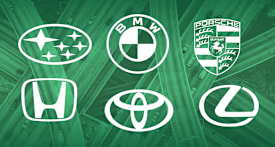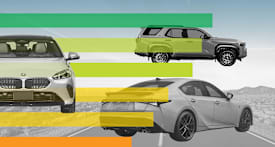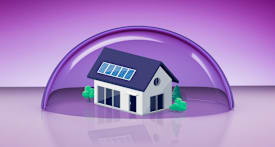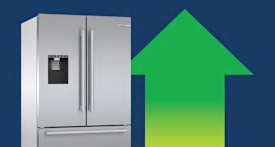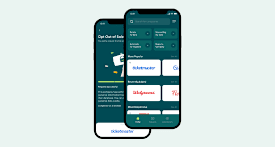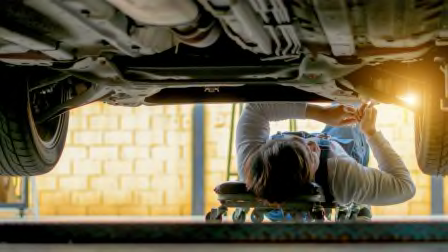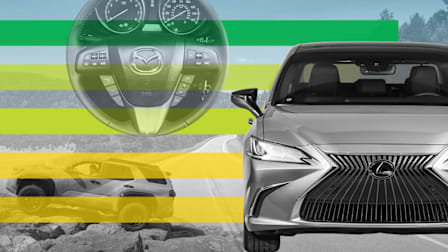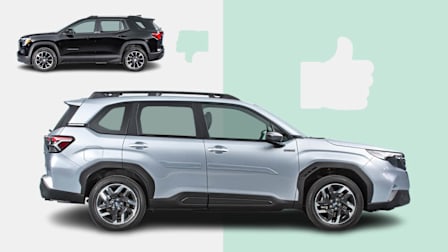How to Save Money Buying a Car, Even If Prices Go Up Due to Tariffs
Cars might get more expensive. Here’s everything you need to know.
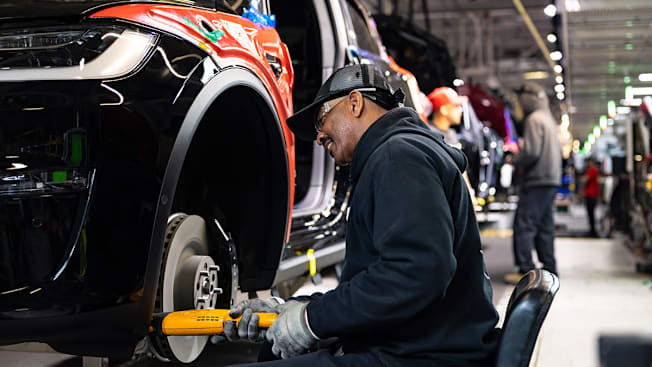
If you’re buying a new car, you’re probably wondering how uncertainty around tariffs will affect prices. You’re not alone. The entire auto industry is working through the White House’s recent announcements and their impact. It still isn’t clear yet how those decisions will ultimately affect consumers, but tariffs could increase prices for all new cars—and even used cars.
- What Are Tariffs?
- What Do Tariffs Mean for Car Prices?
- Will Buying an American-Made Car Save You Money?
- How Can You Tell Where a Car Was Made?
- Could Leasing Avoid the Impact of Tariffs?
- What About Used Cars?
- Should You Keep the Car You Own?
- What About Selling Your Car?
- How Do You Save Money Buying a New Car?
What Are Tariffs?
Tariffs are another name for taxes charged to companies on products they import from other countries. On March 26, the White House announced a 25 percent tariff on new cars and car parts manufactured outside of the U.S., in addition to any existing taxes. Since then, some of those tariffs have been paused, while others have been renegotiated on a country-by-country basis. We expect rates to continue changing for the foreseeable future.
What Do Tariffs Mean for Car Prices?
Industry analysts say that manufacturers may pass the cost of these taxes to customers, ultimately driving up the costs of new vehicles. Currently, the average new car sells for around $49,000, according to Kelley Blue Book. Some automakers have announced discounts and incentives on new vehicles, while others have already increased prices. A few automakers temporarily paused some imports, while others announced changes to where their vehicles are built.
The cost increases may be overt in the transaction price but may also be reflected in the withdrawal of incentives, discounted financing, and subvented leases. As always, it will be important to look at the total cost of buying a car and not focus on the sticker price alone.
For now, estimates from Global Data on behalf of the Autos Drive America trade organization, which represents international automakers with operations in the U.S. (including BMW, Honda, Hyundai, Mercedes-Benz, Nissan, Subaru, Toyota, Volkswagen, and others), project about a $4,000 increase in the price of the average car. Autos Drive America calculates that there would be about $1,000 additional cost over the term of the typical loan. In March, Jennifer Safavian, president and CEO of Autos Drive America, told CR that the actual costs to customers may prove to be even higher, depending on how the tariffs are applied and how each automaker responds.
Further, tariffs may lead some automakers to stop selling specific models in the U.S., notably, lower-priced cars. In recent years, some discontinued imports have been replaced by tall hatchbacks and SUVs, reflecting buyer preferences and contributing to the higher average cost of new cars.
In addition, the Insurance Information Institute predicts that insurance rates will rise, reflecting the newly elevated cost of vehicles and eventually accounting for the increased cost of parts for collision repair.
As always, consumers should look at the total cost for buying a car and not focus on the sticker price alone.

Photo: Hyundai Photo: Hyundai
Will Buying an American-Made Car Save You Money?
Industry analysts from Cox Automotive, Jato, and S&P Global say that tariffs will bring big changes to the auto market. How that shapes up remains to be seen, with many factors in play.
Initially, these tariffs will apply only to vehicles that roll out from factories outside the U.S. However, it’s possible that automakers will increase prices across their entire lineup, regardless of where vehicles are made. In other words, it’s not certain that purchasing an American-made car will save you money.
The logic is, if one specific model’s price increased by 25 percent while competing vehicles’ prices remained the same, customers would avoid the tariffed vehicle. For manufacturers and dealers, spreading a price increase across multiple cars makes the added cost seem less severe to customers. This strategy would likely also apply to specific models that are built at more than one factory, like the Toyota RAV4. It is unlikely that a manufacturer would charge customers 25 percent more for one of two identical models based on the location of its factory. Again, it’s more likely that manufacturers and dealers would spread any extra costs across the entire model line, or even the entire product range.
New legislation means that car buyers who make less than $100,000 yearly ($200,000 if filing jointly) can now deduct up to $10,000 in loan interest on cars assembled in the U.S. According to tax professionals we interviewed, this credit could save qualifying buyers a few hundred dollars a year until it expires in 2028.
Read about the best American-made cars according to Consumer Reports’ recent tests. And discover where tires are made.
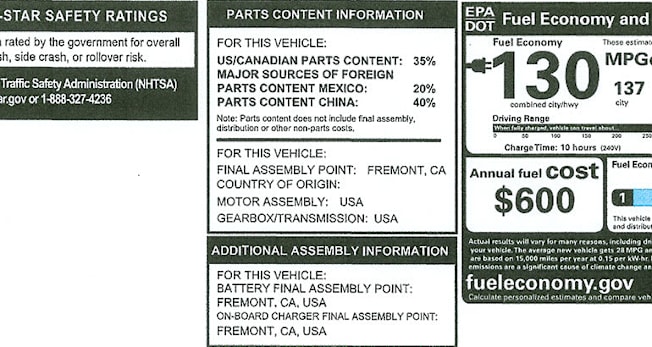
Photo: Consumer Reports Photo: Consumer Reports
How Can You Tell Where a Car Was Made?
Automakers don’t necessarily build cars in the countries where they are headquartered. To find out where a car is built, look at the window sticker or a plate affixed to the driver’s-side doorjamb. What it says might surprise you. For example, the Honda Prologue is an EV from a Japanese company, and it’s assembled in Mexico on a General Motors platform. The Chevrolet Trax is an SUV from an American company that’s assembled in Korea. The BMW X3 is a luxury vehicle from a German automaker, but it’s built in South Carolina.
The tariffs will likely also factor in where a car’s component parts were made, with a carve-out for “preferential treatment” for parts made through the United States-Mexico-Canada Agreement. This could mean that tariffs will apply even to cars that are built in America, like the Tesla Model 3—according to the window sticker for the Model 3 we purchased, 40 percent of its parts came from China.
Could Leasing Avoid the Impact of Tariffs?
Possibly. Leases can temper the affects of price changes. Automakers determine lease payments by estimating the difference between a new car’s purchase price and its worth at the end of the lease. Your monthly payment essentially pays for the depreciation on a new vehicle. Because they’re short-term contracts with fixed monthly payments, a lease can help insulate buyers from unpredictable market forces. For example, we’ve recommended that consumers who are in the market for a new EV should consider leasing, because EV technology and demand are changing rapidly in ways that make future resale value hard to predict. Regardless of what a lease costs, it does lock in your expenses, removing the unknown risk from the impact of future depreciation.
What About Used Cars?
Used car prices are even more complex, but generally follow the rules of supply and demand. When new cars get expensive—prices are already at record highs—buyers gravitate toward used cars. That alone can push up prices. Today’s buyers face the added challenge that supply shortages and factory closures during the early days of the COVID-19 pandemic meant fewer cars were built from 2020 through 2022, reducing the current supply of desirable used cars from recent model years.
Should You Keep the Car You Own?
Broadly speaking, the answer is often yes. However, tariffs may also increase the cost of imported car parts. Big repairs could cost you more tomorrow than they would today. But with limited exceptions, maintaining and repairing your current car is often more cost-effective than replacing it with a new one, even in the best of times.
What About Selling Your Car?
If used car prices increase due to demand, the car you already own might be worth more after tariffs, Fisher says.
“If new car prices go up, your used car will be worth more,” he says. We saw this happen during the early days of the COVID-19 pandemic, when sellers got record-high prices for their used cars. If you get more for trading in or selling your used car, it could help offset tariff-related price increases on the next car you purchase.
How Do You Save Money Buying a New Car?
It’s more important than ever to not rush into a purchase, and to be slow and deliberate about the process. Consumer Reports’ tried-and-true rules for purchasing a vehicle are still relevant and serve as a good starting point for most buyers.
If you require financing, check your credit score and take steps to improve it if it is less than prime. Be sure to pay off current automotive debt rather than rolling it into your next loan—that risks digging a financial hole that can be costly to climb out of.
With that groundwork done, search for the lowest loan rate you can find, and get approved before you head to the dealership. Email dealers to negotiate pricing before you meet with them in person—corresponding this way removes some of the pressure from the interaction.
Use Consumer Reports’ Build & Buy service to check out what others near you are paying for the car you want. This insight, available on CR’s car model pages, can be an especially powerful tool during a period of tumultuous car pricing. The manufacturer’s suggested retail price (MSRP) is likely to be less relevant amid tariffs, when supply and demand will determine prices. Knowing what others paid can inform budgeting, empower negotiations, and even guide you toward a different car from the one you were planning to purchase.
When you do go to the dealership, be prepared for the high-pressure sales tactics. Even after you’ve negotiated the price of the car, they may try to get you to spend more for useless extras and junk fees. Remember, you can always walk away.
CR's Build & Buy Car Buying Service
In addition to research and reviews, Consumer Reports offers members access to the Build & Buy Car Buying Service at no additional cost. Through this service, you can compare in-stock vehicles, see what others paid for the car you want, and customize your payments online. Once you find a vehicle you’re interested in, you can get up-front price offers online from local certified dealers. On top of national incentives, Consumer Reports members are also eligible for additional offers from specific manufacturers. Plus, members can get an instant trade-in value for your current vehicle to use toward your next car purchase.
More on Cars by Brand
@consumerreports Fuel economy can make or break your car purchase 💔 See the vehicles with the best fuel economy through the link in our bio. #cartok #cartiktok #carcommunity #fueleconomy
♬ original sound - Consumer Reports
